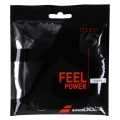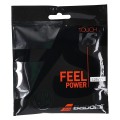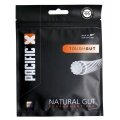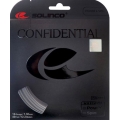extended right of withdrawal
For orders placed from 5th December 2025, an extended right of withdrawal applies until 5th January 2026.
The best tennis string for your playing style

The stringing is the engine of your racket. As the only dynamic part of the racket in contact with the ball, it ensures, among other things, ball control, spin, and power. The best racket never reaches its full potential if the stringing is worn or worn out. Also, the tennis string should support or complement the characteristics of the racket with its properties, not work against them. A high-quality racket designed for comfort and cushioning should also receive a comfortable string with a lot of touch and not a rigid polyester string, or to stay in the initial image, an S-class is only conditionally compatible with the engine of a tractor.
For determining the time when the tennis string should be renewed, regardless of a tear, the following rule of thumb has proven itself: As often as you play tennis in a week, you should renew the string in a year. However, this should be done at least once a year, as the string ages naturally in a tensioned state, regardless of use. Favorable times for a restringing are before the start of the outdoor season in spring and at the beginning of the indoor season in autumn. Those who do not play tennis in the winter half-year should ideally schedule the time for a restringing before the start of the outdoor season. The aging of a string can be even greater with prolonged non-use than with regular use.
Main property
Each tennis string not only has one property, but in a certain ratio all available properties. Main property(ies) are those in which the string has its special strength, for which property this string is specifically designed or what is the property and suitability of the string that comes to the fore.
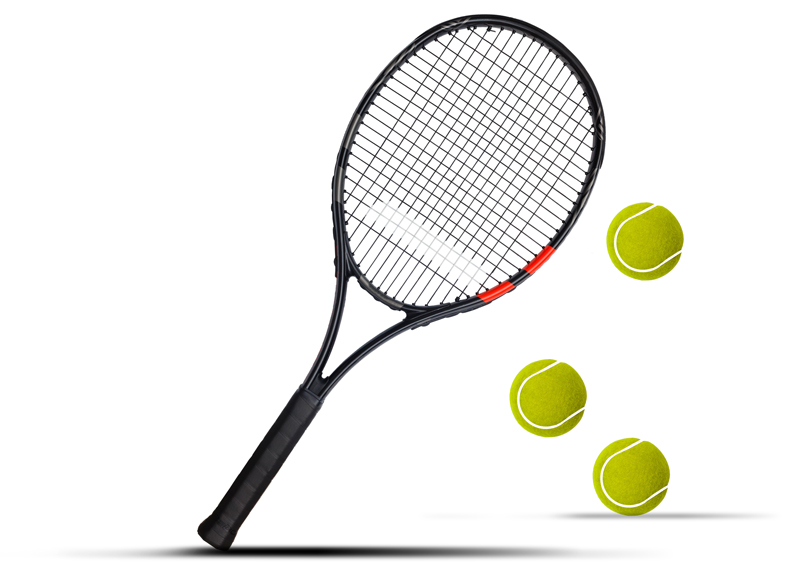

Secondary property
In this context, secondary property means the downstream properties of the tennis string that do not far outweigh all other properties, but still lie significantly above the average of the other properties.
A string with power and spin is not the same as a string with spin and power
The properties in detail
Allround tennis strings
As the name suggests, an all-round string is a string without specific weaknesses, but also without specific strengths. They are designed for a balanced game, many of the often also referred to as synthetic gut strings "standard" polyamide strings are good all-round strings. As with all other properties, these come in different degrees and at different quality levels (e.g. differences in tension constancy, elasticity, or durability due to different material qualities).
all all-round tennis stringsArm protection tennis strings
With every stroke, a so-called impact shock occurs when the ball comes into contact with the string bed, which sets the string/frame system in vibration. Part of the energy in the system goes into accelerating the ball, the other part of the energy is dissipated through the system to the human body (deformation, heating, friction, etc.). The more of this remaining energy is "absorbed" by the string, the better the string filters out or harmonizes individual vibrations, the more arm-friendly it is. In this respect, multifilament strings are far superior to any form of monofilaments.
all arm-friendly tennis stringsDurability
More important than durability in weeks and months is the number of hours of play that a string holds. A polyester string has already lost a large part of its properties after 5 hours of play, a very good multifilament synthetic string after about 30 hours, and a natural gut string after about 40 hours. Therefore, those who have a high string wear and tear (string breaks after less than 10 hours of play) should and must value durability, while those who have a string changed once a year need to consider the durability property less in general.
all durable tennis stringsControl
Every system exhibits a certain inherent scattering of the resulting results even under otherwise identical conditions, a string with good control enables the player to play more precisely and achieve better reproducibility of the results. The amplification of the player's action is relatively low, so that the player achieves a much better control of the result than with power strings. The property of control becomes more important with a wide string bed, a large racket head, very head-heavy rackets, and a game with a lot of power or pronounced swing. Those who have a racket designed for control and want to use a string designed for control increasingly need an exact hitting point, as control strings tend to (further) reduce the sweet spot of the racket.
all well-controllable tennis stringsPower
The higher the elasticity of the string and the faster it follows the movements of the racket, the greater the resulting ball acceleration. Strings with good power provide a relatively large share of energy input into the system for ball acceleration and thus have a significant amplification effect on the player's action. The property becomes more important with a narrow string bed, a small racket head, and a game with relatively little power or relatively little swing. On the other hand, someone who has a racket that develops a lot of inherent power and who also has a strong hitting motion can bring the entire system to oversteer with a power string. With increasing power, the possibility of precise play (control) decreases. Power strings generally enlarge the sweet spot of the racket.
all powerful tennis stringsFeel/Touch
Tennis strings with a medium energy transfer, a certain leveling of the transmitted energy, and a slightly delayed reaction provide the player with more direct feedback and thus a more precise feeling for the shot. If you have a versatile game, a large repertoire of shots, and are not the type of player who can shoot the opponent off the court with brute power, you should attach a certain value to this property. Strings with feel offer the player the opportunity to finely dose his shots in a variety of ways and to use a very precise gradation of possibilities.
all tennis strings with good feelSpin
Strings with spin are designed to give the struck ball an "extra portion" of spin in addition to the ball rotation generated from the racket movement, thus reinforcing the topspin or slice effect. The spin generation by the string can be achieved in different ways: changing the cross-section (e.g. pentagonal, hexagonal strings), additional fiber windings with the resulting wave profile, grooves or milling in monofilament strings, or by a coated and/or dull surface. The stronger the profiling of the string and the more of the aforementioned changes made to the string, the greater the effect. With strings strongly designed for spin, the control is reduced due to the necessarily associated increasing "internal" rotation (side spin or superimposed rotation) of the ball.
all tennis strings with a lot of spin
Diameter
Many, especially simpler and polyester or co-polyester strings are available in a variety of diameters. In principle, the following applies:
- the thinner the string, the greater the power and spin absorption, but the lower the durability and control.
- the thicker the string, the better the control and the higher the durability, but power and spin absorption decrease.
- the stiffer and thicker the string becomes, the less playable it is; therefore, monofilaments usually have a smaller diameter than multifilaments. The higher durability of monofilaments, especially polyester strings, makes thinner strings possible, but also necessary (a 1.25mm polyester string often has significantly better durability than a high-quality 1.30mm multifilament string; accordingly, a 1.35mm polyester string is only suitable for hard hitters or at very high stringing weights).
- thinner strings are generally more elastic than those with a thicker diameter and thus offer better playing support, with increasing diameter, the durability property becomes increasingly important.
- thicker strings better reduce the impact shock and are therefore tendentially more arm-friendly in comparison.
The following rules of thumb should be observed when the same string is available in different diameters:
- Rackets with a large hitting surface and/or open string pattern are more likely to tolerate a slightly thicker string
- Rackets with a small hitting surface and/or tight string pattern should receive a thinner string
- with increasing string hardness, the string should also become thicker to ensure sufficient durability

Color
Some strings - often the simple polyester, copolyester, and polyamide strings - are available in different colors. Dyes are also chemical substances that, solely by their presence, are suitable for modifying the properties of the products. Dyes polymerized into the polymer matrix change the properties more strongly than dispersion dyes (used, for example, in the relatively non-polar polyester strings). Undyed and light strings are often a little softer than their dark counterparts, black strings are usually a little more brittle than other colors. However, different colors (mostly) have only a slight influence on the underlying main properties.
Materials
Polyester/Co-Polyester
are generally produced by a polycondensation reaction of alcohol and carboxylic acid and have a relatively simple structure. The main properties are good workability and extremely high tear resistance. Due to the high brittleness and very low elasticity, processing as a microfiber is extremely complicated, so simple as well as more complex polyester materials are almost exclusively used as monofilament strings, which combine good durability with an affordable price, but continuously lose properties under tension. To reduce this loss of properties, various monomers are often processed together (co-polyester) or a series of additives are added. Therefore, the high-quality strings based on (co)polyester no longer only have pure durability and initially good power and control (depending on the string in a different basic ratio) as properties, but are now also able to offer a certain amount of feel and touch.
all tennis strings made of polyesterall standard co-polyester tennis strings
all premium co-polyester tennis strings
Aramid
Aramid refers to certain aromatic polyamides (brand name: Kevlar). The golden-yellow fibers have high strength, are very tough, and have good vibration damping. They are used as a component in multifilament strings to increase durability and for good shock absorption. Due to the low elasticity, most aramid strings come on the market in the form of hybrid strings, as a pure aramid string would not generate sufficient power.
all aramid tennis stringsPolyurethane
are synthetic fibers formed by polyaddition reaction of polyisocyanates with polyols, soft, elastic, with comparatively high tear resistance, and are used in strings as a soft protective cover or as shock-absorbing fibers to increase comfort. Pure PU strings are not produced, in very high-quality strings (Tecnifibre TGV), up to 40% PU content is included.
all polyurethane tennis stringsPolyamide
Polyamides, commonly referred to simply as nylon, are polycondensation products of a carboxylic acid and an amine. Due to the mixed use of various aliphatic and aromatic starting compounds, there is a sheer variety of polyamides with a wide range of properties and different quality levels. They all have high strength, stiffness, and toughness, as well as excellent workability and good dynamics. There are both very simple classic strings made of polyamide (e.g. Prince Tournament Nylon), as well as extremely high-quality strings with very specific properties (e.g. Prince Premier for outstanding playing feel and arm protection). Simple polyamide strings mostly have good all-round properties. The high-quality "premium" (co)polyamide strings are characterized by high wear resistance, very good sliding and dynamic properties, and a good playing feel. Polyamides, along with polyester materials, are by far the most commonly used polymer material for tennis strings and are well suited for "custom-made" materials and specific string properties.
all tennis strings made of polyurethanePEEK Polymers
Polyetheretherketones are among the most expensive technical plastics and are usually produced by alkylation of bisphenol salts. They have thermoplastic properties and are therefore much more stable under tension and more comfortable to play with in monofilament strings compared to even the highest quality conventional or modified polyester strings, while also being more durable. This allows for the construction of monofilament strings with very small diameters. In extremely high-quality multifilament strings (e.g. Gamma LiveWire), additional fine PEEK fibers are used to increase the string's resistance.
all tennis strings made of PEEK polymersNatural Gut
As the name suggests, this is a natural product. The production of a good gut string requires the intestines of three cows, which are processed into a string in a multi-stage and complex process. The most important component determining the properties of a gut string is collagen. The triple helix of this structural peptide has enormous tensile strength and has a very stable and almost untwisted structure. As a result, natural gut strings have a tension constancy that cannot be achieved by any synthetic string, provide outstanding direct and yet "soft" playing feel, and have excellent arm protection. High-quality gut strings counteract weather susceptibility (swelling from water, drying out from heat) by the manufacturer's plasticization of the individual fibers with polyurethane. Like high-quality multifilament strings, these strings need a certain amount of time to be played in order to achieve their properties. In practice, it is quite difficult to switch from polyester to natural gut, so a hybrid combination (as used by Federer, Djokovic, or Roddick, among others) may be considered to address reduced durability.
all tennis strings made of natural gutPolyolefins
Polyolefins are saturated hydrocarbons that are formed by radical polymerization and are the most important group of plastics. Polyolefins are robust and very flexible, often highly viscous plastics with low density and high tensile strength. In addition to being processed independently, especially in fiber tapes that provide excellent control and playing feel in a range of high-quality strings (e.g. Isospeed Professional), polyolefins are also used as protective coatings for simpler strings, alongside polyurethanes.
all tennis strings made of polyolefinsOther Copolymers
Copolymers are basically all polymers composed of two or more different monomers, and therefore have special and targeted properties. Most high-quality strings are copolymers. In addition to the aforementioned (co)polymers, tennis strings also use polyethers, special aromatic polyesters, polyfluorocarbons, terpenes, and more, mostly to create specific properties (e.g. special elasticity, strong cross-linking, high abrasion resistance, special surface structures, etc.).
all tennis strings made of other copolymers
String Tension
An optimal adjustment of racket and string to the respective player also means choosing the right string tension. The following dependencies generally apply:
- as string tension increases, ball control also increases, while power and durability decrease
- as string tension decreases, power and durability increase, while control decreases
The following rules of thumb can be applied:
- for a 100in² racket with a 16/19 string pattern, the usual average for a standard string with 26kp lengthwise and 26kp crosswise can be used. For oversize frames from 105 to 112in², this changes to 27kp lengthwise, 26kp crosswise, frames over 112in² are at 28/27kp, for frames with 95in², the average decreases to 26/25kp, and for even smaller frames to 25/25kp.
- a tight 18/20 string pattern should be strung 1 to 2kp less tightly than an open 16/19 string pattern
Construction

Monofilament
Monofilament strings are simply constructed compared to all other strings, they consist of only a single strand. The differences between the strings lie in the processing and the use of different materials or material combinations.
Monofilament strings include simple "classic" polyester strings (e.g. Kirschbaum SuperSmash) through various types of copolymers ("soft polyester", e.g. Babolat Pro Hurricane) to very high-quality PEEK strings (e.g. Luxilon Alu-Power).
The strings are usually stiff, the (initially) very good power decreases in a relatively short time and the strings lose their "crisp" playing feel
Advantages
- Durability
- firm hitting feel
- little string slippage
Disadvantages
- low tension constancy
- (mostly) little comfort
- no arm protection
Suitability
- Players with high string wear
- "Hard hitters"

Multifilament
are usually highly technical constructions made up of up to over 1500 individual fibers in various construction types made of various, often very high-quality materials. Many strings are unique and tailored to very specific properties (e.g. Tecnifibre TGV for maximum shock absorption and arm protection, Gamma LiveWire Professional for a playing feel close to natural gut). All multifilament strings have good arm protection, high elasticity and high playing comfort.
Advantages
- very good arm protection
- lots of playing feel
- high elasticity over a long time
Disadvantages
- significantly lower durability compared to monofilaments
- Strings sometimes need to be broken in
Suitability
- Players with arm or shoulder problems
- Players looking for maximum playing feel and touch

Core with Filaments
Besides monofilament strings, this is the most commonly used string type. There is a huge range - from simple and inexpensive nylon strings, which consist of a core with a single-layer filamentation (e.g. Prince Tournament Nylon) to very complex structures with multiple cores and multi-layer wrappings made of different high-quality materials (e.g. Head FXP). The properties are correspondingly diverse. The simpler constructions are considered good all-round strings (Type Synthetic Gut), with the "better" ones, individual properties are additionally emphasized (e.g. Babolat MagicForce with a lot of power).
Advantages
- no weak point
Disadvantages
- often no outstanding property
Suitability
- Players with normal string wear, looking for balanced playing properties

Band Structure
are constructed like multifilament strings, but here individual fibers are completely or partially replaced by interwoven bands (e.g. Isospeed Professional).
Compared to multifilament strings, they often offer better control
Advantages
- very good arm protection
- lots of playing feel
- high elasticity over a long time
Disadvantages
- significantly lower durability compared to monofilaments
- Strings sometimes need to be broken in
Suitability
- Players with arm or shoulder problems
- Players looking for maximum playing feel and touch

Natural Gut
Natural gut strings are still unmatched in terms of elasticity, tension stability and "performance" over the entire life of the string. They are usually made from cow intestines in a multi-stage process. Weather resistance has been significantly improved through elaborate technical processes (e.g. plasticization of the individual fiber structures with special polyurethane materials).
Advantages
- best possible all-round properties
- no decrease in properties over time
- lots of touch and arm protection
Disadvantages
- relatively high price
- slight weather dependence
Suitability
- Players who have no problems with durability and are looking for maximum comfort

Hybrid
Hybrid strings are a combination of different main strings (often a monofilament) and cross strings (often a multifilament string). This is an attempt to combine the advantages of several string types and different properties. The combination possibilities themselves are almost unlimited; the pre-configured hybrid combinations offered by the manufacturers in most cases represent a combination of durability and playing feel.
Advantages
- Combination of properties that are unattainable in a single string
Disadvantages
- The disadvantages of the individual strings are also combined
Suitability
- Players with high string wear who still do not want to compromise on playing comfort or arm protection

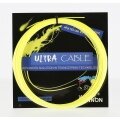

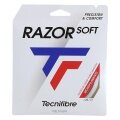


-120x120.jpg)
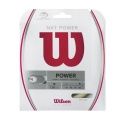


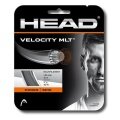
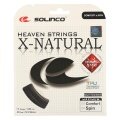















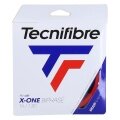
-120x120.jpg)




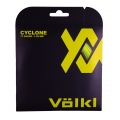








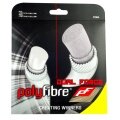



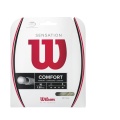
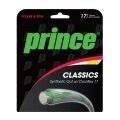
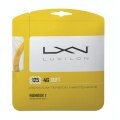
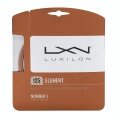
-120x120.jpg)
